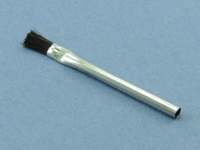|
Outline
This procedure covers the reballing of BGA components.
|
|||||||||||||||||||||||||||||||||||||||||||||
|
Procedure
Procedure - Braid Ball Removal
Procedure - Reflow Oven Attachment
|
|||||||||||||||||||||||||||||||||||||||||||||
Images and Figures
BGA Component Reballing, Braid Ball Removal, Reflow Oven Attachment Method

Figure 1. Remove existing solder spheres on BGA components using desolder braid.

Figure 2. Apply tacky flux to flat BGA component pads using a brush

Figure 3. Place the BGA components into a fixture and cover with a matching stencil.

Figure 4. Run the fixture and components through the reflow oven.
|
|||||||||||||||||||||||||||||||||||||||||||||
9.4.2 BGA Component Reballing, Braid Ball Removal, Reflow Oven Attachment Method
Procedure covers BGA component reballing using solder braid ball removal and reflow oven attachment.
Minimum Skill Level: Expert
Conformance Level: High
REQUEST FOR QUOTE GUIDES INDEX

BGA Component Reballing, Braid Ball Removal, Reflow Oven Attachment Method

Remove existing solder spheres on BGA components using desolder braid.

Apply tacky flux to flat BGA component pads using a brush

Place the BGA components into a fixture and cover with a matching stencil.

Run the fixture and components through the reflow oven.

We're here to help with all your challenging circuit board and electronic component rework and repair needs.
LEARN MORE
SLIDESHOW STARTING
❮
❯





















